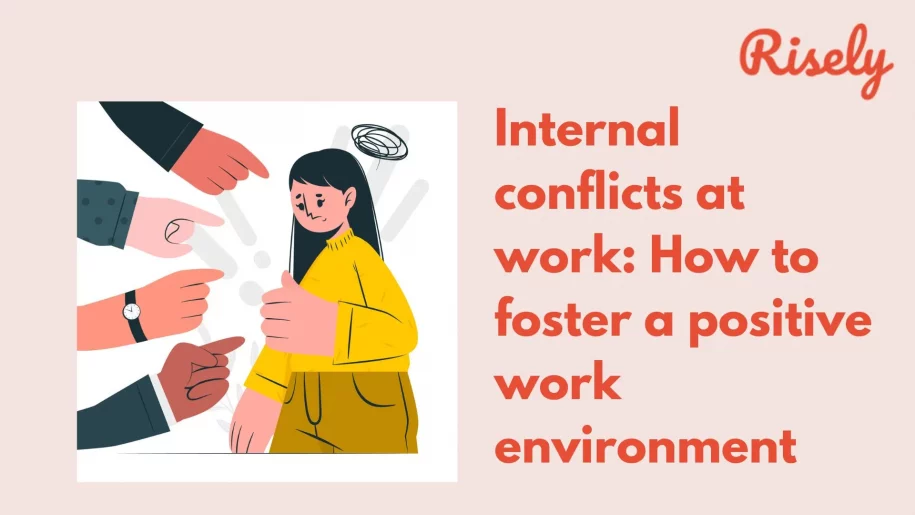Internal conflicts at work: How to foster a positive work environment
Conflicts are not uncommon in the workplace. They can arise due to differences in opinions, values, communication styles, or competing goals. If not managed effectively, internal conflicts can result in reduced teamwork, increased stress, and a toxic work environment. As a manager, it’s crucial to understand the causes and effects of internal conflicts and take proactive steps to prevent and manage them. In this blog, we will look deeper into internal conflicts in the workplace, explore their causes and effects on team members, and provide practical ways for managers to avoid and resolve internal conflicts. So, let’s learn how to foster a harmonious and productive work environment by effectively managing internal conflicts.What is an internal conflict?
Internal conflict is a disagreement within an employee’s mind or emotions rather than between employees or teams. It is often characterized by conflicting thoughts, feelings, values, or beliefs that create tension or stress within the employee, affecting their work performance and overall well-being. Internal conflicts in the workplace can arise from various sources, such as conflicting priorities, differing personal and professional values, mismatched expectations, unresolved emotions, or competing goals. For example, employees may experience internal conflict when they are torn between two equally important tasks and unsure which one to prioritize. Or they may face a moral dilemma that challenges their values, causing emotional turmoil. Internal conflicts can impact an employee’s productivity, decision-making abilities, and job satisfaction. If left unresolved, they can also lead to increased stress, decreased motivation, and reduced overall performance. Read more: 5 Secrets To Conflict Resolution At Work For ManagersOther Interesting Reads
What causes internal conflicts in the workplace?
Internal conflicts in the workplace can arise from various sources, including:- Conflicting priorities: When employees face multiple tasks or responsibilities competing for their time and attention, they may experience internal conflict in deciding how to allocate their resources effectively.
- Differing values or beliefs: Employees may experience internal conflict when their values or beliefs clash with the organization’s values or policies or those of their colleagues.
- Mismatched expectations: Misaligned expectations between employees and their managers or colleagues can lead to internal conflict.
- Role ambiguity: Unclear or ambiguous job roles or responsibilities can lead to internal conflict. Employees may experience conflict when unsure about their roles or when their roles overlap with those of their colleagues, resulting in confusion and frustration.
- Cognitive dissonance: Refers to the discomfort or conflict that arises when an individual holds contradictory beliefs, attitudes, or values. In the workplace, employees may experience cognitive dissonance when their actions or behaviors are inconsistent with their beliefs or values, leading to internal conflict.

What are the effects of internal conflicts on team members?
Internal conflicts in the workplace can have various effects on team members, including:- Reduced productivity: Internal conflicts can significantly distract team members’ time and energy, leading to reduced productivity. When team members are caught up in internal conflicts, they may focus less on their work tasks, leading to lower efficiency and output.
- Lower morale and job satisfaction: Internal conflicts can create a negative work environment and impact team members’ morale and job satisfaction. When team members experience conflicts with their colleagues or within themselves, it can create stress, tension, and dissatisfaction, affecting their overall job satisfaction and motivation.
- Increased stress and burnout: Internal conflicts can cause stress and emotional strain on team members. Managing conflicts can be emotionally taxing, and prolonged conflicts can increase stress levels and even burnout, harming team members’ mental and physical well-being.
- Damaged relationships and team dynamics: Internal conflicts can strain relationships among team members and damage team dynamics. Conflicts can create mistrust, resentment, and breakdowns in communication, leading to strained relationships and deteriorated teamwork. This can have long-term effects on team cohesion and collaboration.
- Increased turnover and absenteeism: Internal conflicts can contribute to increased turnover and absenteeism among team members. When conflicts are not effectively resolved, team members may become disengaged or seek opportunities elsewhere, leading to a turnover. Absenteeism may also increase as team members must avoid conflict or the associated stress.

What steps can managers take to avoid internal conflicts?
Managers play a crucial role in preventing and managing internal conflicts in the workplace. Here are some steps that managers can take to avoid internal conflicts:- Foster open communication: Establish a culture of open communication where team members feel encouraged and empowered to express their thoughts, concerns, and feedback. This includes active listening, opportunities for team members to share their perspectives, and promoting transparent and honest communication channels.
- Set clear expectations and goals: Communicate expectations, goals, and roles to team members to avoid confusion and misunderstandings that can lead to conflicts. Ensure that team members understand their responsibilities, reporting lines, and performance expectations, and regularly revisit and clarify these as needed.
- Provide conflict resolution training: Offer training programs or workshops on conflict resolution skills to team members to equip them with effective communication, negotiation, and problem-solving skills. These skills can help team members proactively manage conflicts and constructively resolve them.
- Promote collaboration and teamwork: Encourage collaboration and teamwork among team members by fostering a cooperative and inclusive work culture. Promote opportunities for team members to work together, share ideas, and collaborate on projects, which can help build positive relationships and prevent conflicts.
- Address conflicts early and proactively: When they arise, address them early to prevent them from escalating. Provide a safe space for team members to voice their concerns and grievances and take appropriate steps to resolve the conflicts fairly and impartially.
- Encourage diversity and inclusion: Embrace diversity and promote inclusion in the workplace. Create an environment where diverse perspectives and opinions are valued and team members feel included and respected. This can help prevent conflicts arising from differences in backgrounds, values, or beliefs.
Conclusion
In conclusion, internal conflicts in the workplace can have detrimental effects on team dynamics and overall productivity. As a manager, it’s essential to recognize the signs of internal conflicts, understand their causes, and take proactive steps to prevent and manage them. Managers can create a positive work environment where conflicts are managed constructively by fostering open communication, setting clear expectations, promoting collaboration and teamwork, providing conflict resolution training, and promoting work-life balance. Managing internal conflicts requires proactive efforts, effective communication, and positive work culture. Creating an environment where team members feel heard, respected, and supported is essential. By implementing the ways shared in this blog, you can build a cohesive and high-performing team that works together towards common goals, resulting in a more productive and harmonious work environment.Discover the conflict management errors that are holding you back with a free assessment.
The free conflict management assessment helps managers and leaders overcome critical challenges.
Frequently asked questions
What are internal and external conflicts?
Internal and external conflicts are two different types of conflicts. Internal conflict refers to a psychological struggle that occurs within an individual. It is typically a conflict between opposing thoughts, emotions, or desires within a person.
External conflict, on the other hand, refers to a conflict that arises between individuals or groups. It can involve differences in opinions, values, interests, or goals.
External conflict, on the other hand, refers to a conflict that arises between individuals or groups. It can involve differences in opinions, values, interests, or goals.
What are examples of internal conflict?
Example of internal conflict: An employee who is torn between speaking up about an issue they have noticed in the team but fears potential repercussions or backlash from colleagues or superiors. This internal conflict may create anxiety and stress for the employee.
How do you handle internal conflict in the workplace?
Handling internal conflict in the workplace:
– Reflect and self-manage
– Seek support
– Communicate effectively
– Find common ground
– Reflect and self-manage
– Seek support
– Communicate effectively
– Find common ground
Other Related Blogs
5 Frameworks to Master Prioritization Skills
Ever feel like your to-do list has morphed into a never-ending monster, overflowing with tasks and projects all vying for your attention? You’re not alone. As a manager, juggling priorities…
The Ultimate Guide to Prioritization Principles:5 Ways of Sorting Out What Matters Most
Do you ever feel overwhelmed by the sheer amount of work? Do you struggle to focus on the most important tasks and feel like you haven’t accomplished much at the…
Overcoming prioritization challenges at work: 8 Strategies for success
Overcoming prioritization challenges at work: 8 Strategies for success Professionals are constantly faced with overwhelming tasks, projects, and responsibilities. With limited time and resources, effective prioritization has become a crucial…
Top 8 prioritization interview questions and its importance
Top 8 Prioritization Interview Questions and Its Importance The ability to prioritize tasks effectively has become crucial for professionals in virtually every industry. With multiple deadlines, competing demands, and limited…


